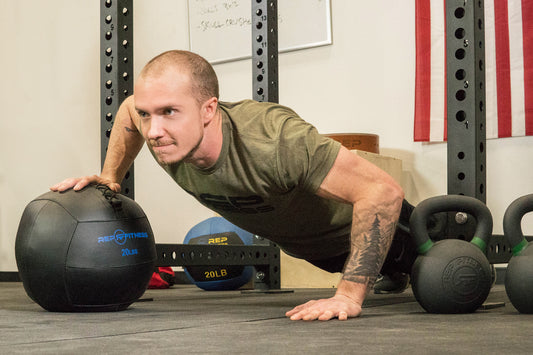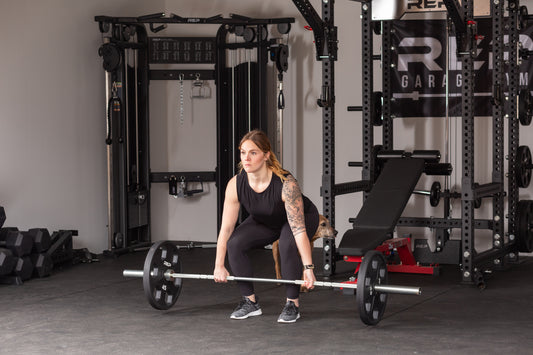
The Safety Squat Bar is a specialty barbell with cambered ends and handles that bring your hands in front of your body, rather than out to your sides like a straight barbell.
It looks hardcore. Like part of some kind of sci-fi Viking robot warrior. And in some ways, the SSB is extra challenging. It sits higher on your shoulders, forcing you to fight to stay upright instead of crumbling forward like a sad taco. Add to that ends that drop the weight below bar height, and you’ve got a totally different breed of squats. Brutal and humbling. Not necessarily harder or easier than traditional back squats, but indisputably different. You’ll probably have to drop weight.
But in other ways, this specialty bar is pretty forgiving. It massively reduces the stress on your upper body, in particular your elbows, shoulders, and wrists. There’s a reason — a ton of reasons, actually — why the SSB is a beloved (and sometimes lovingly despised) exercise among lifters, from Strongmen to powerlifters to gym rats who want to improve their squats (or keep hitting legs with fewer demands on the upper body).
Here’s why you need to add a Safety Squat Bar to your training — and all the different ways you can use it. Hint: It’s way more than just back squats that make you look like a cyborg.
WHY USE A SAFETY SQUAT BAR?
Due to its unique shape, the SSB (also called a Safety Squat Yoke Barbell) can help you gain strength, relieve upper body discomfort or pain, prevent injury, improve your squat form, preserve your upper body strength, and more. Here’s how:
- Strength: With the bar pitching you forward and higher on your shoulders, you are forced to really engage your core and upper back. Because of that, SSB squats have a vertical position that looks more like a front or high-bar squat. As such, SSB back squats tend to really fire up the quads, as well as minimize the pressure on the lower back. The more upright your torso, the less stress on your lower back. The bar demands your quads step in. This position can also allow more range of motion through the lower-body joints (and make it easier to hit depth). Different exercises with the SSB will hit different muscle groups (see next section).
- Relieve upper body pain: Holding handles in front of your body takes a ton of strain off your shoulders, elbows, and wrists; you don’t need to externally rotate your shoulders with this bar. It can also allow you to keep squatting with a pec injury. Even if you’re not injured, the SSB can help you squat with reduced shoulder and chest mobility, while you work on improving your range of motion.
- Injury/pain prevention: Feeling elbow tendinitis creeping in? Swap to the SSB while you rest it. Plus, the bar pad wraps around your neck, so the metal doesn’t dig into your spine/neck.
- Technique: The SSB can improve your ability to remain upright under a traditional barbell and help you train not to let your chest collapse. Because the SSB places the bar load on your center of gravity, it’s easier to maintain proper form during the squat. This muscle awareness and memory translates to a straight bar.
- Preserve upper body: This bar gives your upper body a break, preserving your shoulders and chest and allowing them to properly recover for your next upper body day. Save your shoulders for OHPs or heavy bench. Don’t waste them on squats.
HOW TO USE A SAFETY SQUAT BAR?
Although back squats are the most obvious use of the SSB, that’s just the beginning of how you can use it. Especially with a SSB with removable handles. Here are some other exercises to try:
- Good mornings/seated good mornings/single-leg good mornings/upper back good mornings
- Hatfield squats. Yes, you can let go of the handles and it will still balance on your traps.
- Front squats. The pad and handles make these more comfortable than front squats with a straight bar and even make front squats possible for people with wrist issues.
- Box squats
- Bulgarian split squats
- Step-ups
- Single-leg Romanian deadlifts
- Calf raises
- Zercher squats
- Lunges/walking lunges. Using a bar for lunges doesn’t limit the weight to your grip strength. And if you let go of the SSB for a moment to catch your balance, the SSB will remain in place, whereas you must keep both hands on a straight bar at all times to keep it from rolling off.
- Hip thrusts/glute bridges
- Overhead press. Bonus: If you have a low ceiling, the camber puts the weight lower than the center part that you grip, so you have more clearance for plates on the barbell. Remove the handles so you don’t worry about hitting your face or head on them and can maintain a proper bar path.
- Triceps press/JM Press. Remove the handles to keep them out of the way.
- Skull crushers
- Shrugs
- Side bends
The list of exercises goes on and is mostly limited by your creativity, making the Safety Squat Bar an incredibly useful, versatile, and fun new challenge to add to your home gym.



